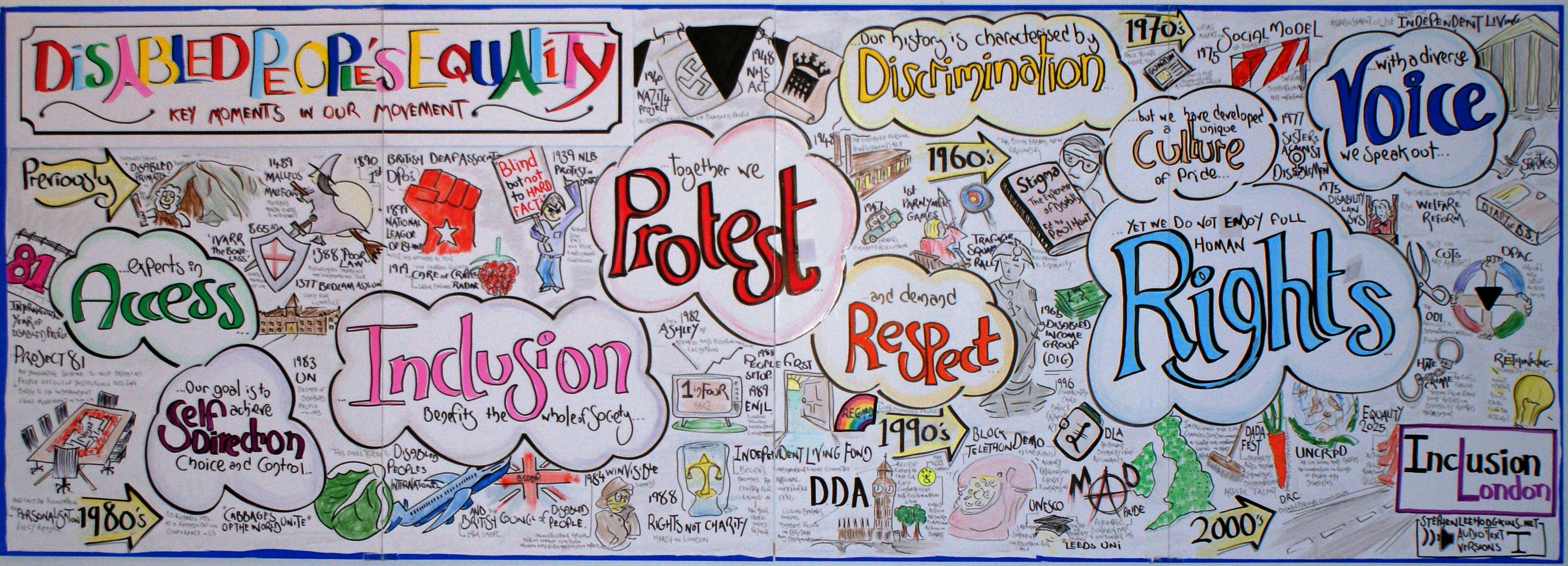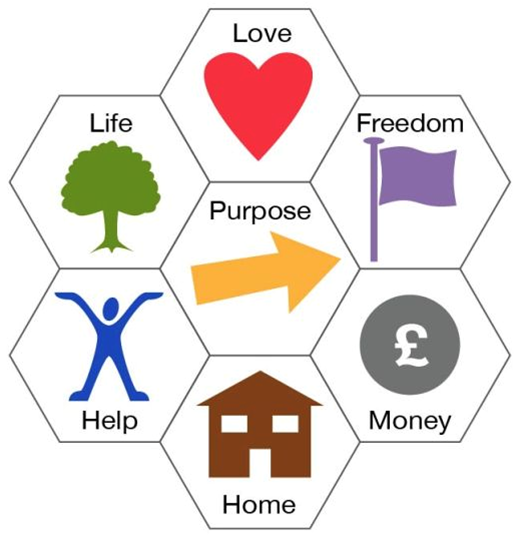Use the social model of disability
What this means
The Leading The Lives We Want To Live group draws inspiration from the social model of disability. This is a model developed by disabled people themselves, and states that people do not ‘have disabilities’. They have impairments, and are disabled by barriers in society. Barriers can include the physical environment, people’s attitudes, communication, how organisations and systems are run, and discrimination. If society was truly inclusive, these barriers would not exist - disability is caused by society’s unwillingness to meet the needs of people with impairments.
What does Leading the Lives We Want to Live mean to you?
In the video below, Katie Clarke outlines the importance of accessibility:
It is not only the model itself that’s important. It is the way it was developed, through the activism of disabled people. There is power and solidarity in sharing stories, experiences and knowledge between and beyond ourselves. This peer support doesn’t have to be official, it can spring up whenever people get together.
If there is a key foundation that professionals need to have when supporting disabled people to live the lives they want to live, it is to understand, promote, and explicitly support the social model of disability.
What does Leading the Lives We Want to Live mean to you?
In this video, Jenny Hurst explains the importance of being given the same opportunities as non-disabled people:

Illustration reproduced with the kind permission of Inclusion London.
We need to talk about an acceptable quality of life, and this shouldn’t just be decided by professionals.
Why is it so important for professionals to know about the social model of disability?
Katie Clarke explains why it's important for professionals of all levels to learn about the social model of disability:
The research
Fenney et al. (2022), in research conducted for the King’s Fund and Disability Rights UK, found that people often experience the ‘medical model’ of disability in both health and social care - where professionals would start from how to ‘fix’ a condition, or having a conversation about how people could adapt themselves to fit in better with their environment.
The people who were part of this study connected the medical model with a poor experience of care, and contrasted this with more positive experiences that started with feeling seen as a ‘whole person’. Personalisation, and direct payments or personal budgets, can also promote the social model of disability, and help workers move from theoretical knowledge about the model to its use in practice (Glasby, 2012). However, it’s important that there is proper information and support for this (see the section ‘Communication and confidence’).
The social model of disability can sometimes be (wrongly) assumed to apply only, or mainly, to younger physically disabled people (Kattari et al., 2017), with older people more likely to be seen in the light of the medical model of disability. However, as the Mental Health Foundation (2015) found, using the social model of disability in dementia can support the agency of a person with the condition. The model also helps reframe dementia away from something seen as an exclusive and inevitable condition of older age – and, as a rights-based model, affirms people’s rights to high-quality services.
The Leading the Lives We Want to Live group were also inspired by Simon Duffy’s 'Keys To Citizenship' model:

(Duffy, 2003)
Although originally developed in the context of people with learning difficulties, these are solid principles for living well and supporting one another. Thinking about citizenship can aid joined-up thinking, because it illustrates the links between relationships and structural aspects in society, while acknowledging the barriers people may face in claiming their citizenship rights (MacIntyre et al., 2022).
The role of peer support, and peer advocacy, can have a powerful impact on people’s lives. Power et al. (2016), whose co-produced research concentrated on people with a learning disability, found peer advocacy could help people problem-solve, make friends, informally learn and share knowledge and skills. In the particular context of austerity in the UK, where services have been cut, peer support was one way of partially filling the gap of retreating day and community facilities (Power et al., 2016). Hyslop el al. (2020) also found high value in peer networks for people with personal budgets – disabled people sharing knowledge and stories about personal budgets helped to build people’s confidence at each stage of obtaining and managing a personal budget.
What you can do
If you are in direct practice: Do not wait to be trained in the social model of disability. Find out about it for yourself!
Watch Jenny Hurst talk about the social model in the video below, and go to the further information section below and learn about it. Speak to the people you work with, both those with care and support needs and other professionals, about its importance. What does it mean to people?
Think about the role of peer support and peer advocacy in your local area. Are there local groups you can connect people up with? How can you support bringing people together, so they may share their stories and knowledge without the power dynamics of non-disabled professionals being present?
If you are a senior manager: The Leading The Lives We Want To Live group suggested a wide and sustained campaign to promote the social model of disability – posters in buildings, reminders in letters, training delivered by disabled people on what this means (and how to apply it).
How can you, as an organisation, do this? How will you promote knowledge about the social model of disability – in its widest sense, including older people? Are you confident there is a shared understanding of the model, and how it should underpin work with people with care and support needs? And who judges this – is it the organisation itself, or disabled people?
Further information
Read
Disability Rights UK has an introduction to the Social Model of Disability.
Watch
There are several accessible videos made by disabled people explaining what the social model of disability is and why it’s important:
Disability Wales offer a short, clear explanation from Natasha, a Deaf person (Natasha also talks about the cultural and linguistic models of Deafness in the video).
The National Disability Arts Collection and Archive has created an animation explaining the meaning and history of the model.
SCIE’s co-production steering group created a film on the social model of disability for Co-production Week in 2020. Finally, Disability London has a British Sign Language (BSL) explainer of the model.
Read
The Greater Manchester Coalition of Disabled People has published A Brief History of Disabled People’s Self-Organisation.
Engage
Social Care Future publishes regular blogs by and for disabled people and their allies.
Explore
The People’s History Museum in Manchester has an exhibition, Nothing About Us Without Us, that explores disabled people’s activism – past, present, and future. Even if you can’t get to the museum itself, the website hosts films, guides, and a visual story about the exhibition.
